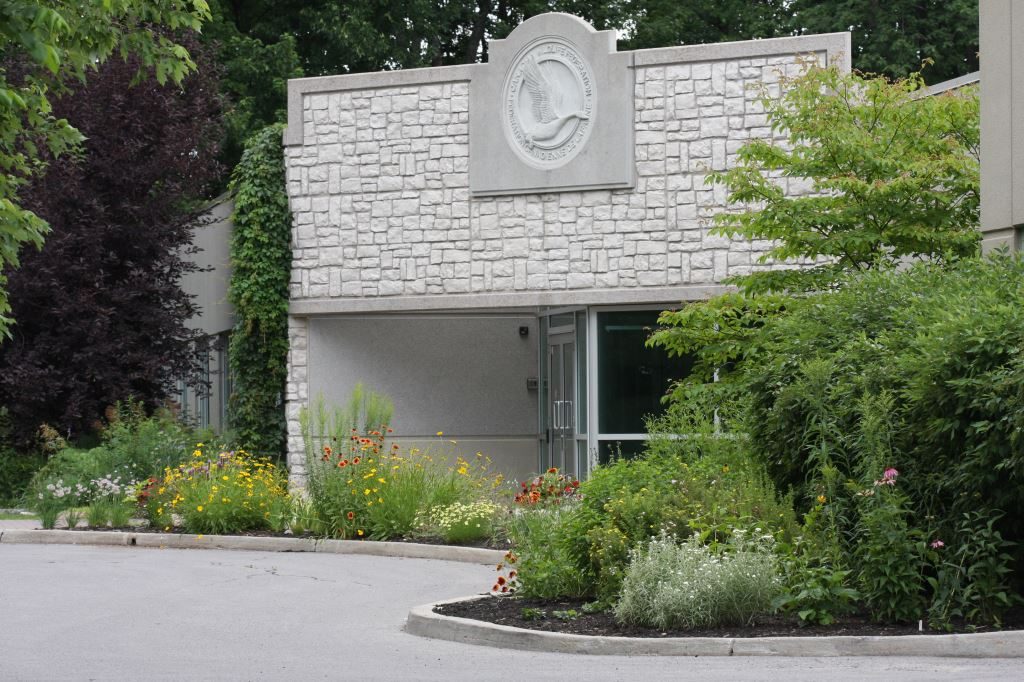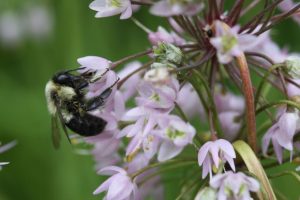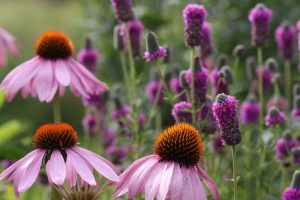by Sarah Coulber

Just to the right of the main entrance to the CWF building, visitors can enjoy a water feature, a diversity of wildflowers, and often some of the wildlife that use the garden.
The Canadian Wildlife Federation is a national charitable organization that has been around since the early 1960s. A large part of our work is helping Canadians discover, enjoy, and conserve our important and remarkable wildlife. We do this via programs, print material, web resources, webinars, and workshops – and our wildlife-friendly demonstration garden around our headquarters in Kanata (Ottawa), Ontario.
There have been some challenges including variable budgets over the years, litter, stolen plants, and nearby development that changed the water flow affecting many of our mature trees and one of our garden beds. Overall, however, these challenges have been manageable and the benefits far outweigh the problems.
Benefits of the garden
The garden is a great way to show people that native plants can actually be quite pretty, that logs are beneficial and can be discreetly placed in the tidiest of gardens, and that organic gardening is really quite simple and most people do lots already.
It can also be an opportunity to see wildlife. At a planting event with volunteers one of the children was thrilled to see a bumblebee hanging from a flower. It turns out it was their first time seeing a bee and that they’d always wanted to see one!
Our garden has other benefits, too. It is useful for taking photos of the plants (and sometimes animals that visit) for use in our presentations, on our website and in our print material. They sometimes make guest appearances in magazines, exhibits, and websites beyond ours, too.
Cost
We generally budget enough money to hire a gardener at minimum wage, or slightly higher, for four months (May – August) and, depending on the year, to buy a few plants and mulch or compost. We bought most of our plants when the gardens first started and a few years following. Since then, we have added small quantities, except during a couple of events funded by Foresters Financial and TD Tree Day who, in addition to funding, also provided wonderful volunteers for planting.
We save our seeds and, although we don’t have a nursery yet, it is an idea that may one day become a reality.
Maintenance
Although wildlife-friendly gardening can save time, a garden of this size definitely requires maintenance, especially when new plants are added or extreme heat hits.
For a few years, our budget was reduced or non-existent, and we only had part-time staff or volunteers. It was wonderful to have friendly and interested people help care for our gardens and enjoy learning about native plants. However, reduced help meant the gardens had less attention and, in the case of volunteers, more time on my part finding, guiding, and supporting people. Despite this, it has always been important to ensure that whoever is helping in the garden knows my door is always open and to ask as many questions as needed. This helps them and also minimizes accidental weeding of native plants, etc.
Having some continuity makes such a difference, as we experienced when one gardener was able to stay for three seasons. We are now reaching out to a local horticultural society in hopes that they have members who would like to volunteer here. In addition to their interest, which is always key, they would presumably have some knowledge and might be willing to help regularly and from year to year.
Visitors
As we are in a business park, albeit the wooded side of one, we don’t get as much traffic as a community park or other more exposed locations.
Although we are not actively advertising the garden locally, we do have the odd group come visit each year, and some individuals have come on their own. For them, we have signs in the garden beds to explain a bit about each bed and some of the plants in them.
A teacher from the Montessori school across the road brings students over regularly for a mix of interpretive learning (what birds do they notice? what trees live here?), forest play (balancing along our fallen trees and over rocks), as well as learning risk assessment (notice all around you to see if is safe to walk under the swaying trees or on the frozen creek at this time). The children love it, and I’m told by them and others that they hear more birds on our property than other treed areas nearby. Next year, they plan on helping care for one of the gardens that has our more whimsical features, such as fairy houses.
We are gradually expanding the features on site and are exploring what makes the most sense in terms of promoting the garden with local schools, etc.
Online maps
For those who can’t visit in person, online maps allow the user to click on a bed to learn about its conditions and plants. These have been very useful and for a time could be printed into a little booklet for those wanting to visit the gardens in person soon after.
The challenge was securing the resources to create the maps in the first place. Fortunately, we were able to find college students to create ours, which saved money and gave the students fantastic work experience. It was a huge job that they only finished on the last day, so there wasn’t sufficient time for my colleague and me to properly review and provide feedback.
For anyone thinking of going this route, try to be clear on what is expected with the students and spell out even the most basic points, such as time for revisions. Depending on how the maps are done, you may need to keep them static and explain that they represent a snapshot as of a certain date, so that as beds evolve, your future visitors won’t be confused and you won’t need to spend time or money revising the maps as your garden evolves.
Ideas to consider
If you are thinking of starting a garden, I hope you go for it – the community at large can greatly benefit, and you can keep it as small and manageable as you need. Be aware of all the benefits you as you discover them along the way and promote them to all relevant parties such as funders and the community that use the space. You might inspire others to join in with you. The more people who either participate in your garden’s care or who are aware of the good you are doing, the greater the chance of the garden – and its positive messaging – reaching its full potential.

The CWF’s wildlife-friendly garden includes native trees, shrubs, vines, and grasses in addition to the many showy flowers.
Sarah Coulber has been with the CWF’s Gardening for Wildlife Program since 2002. She writes about the benefits and how-tos of wildlife-friendly gardening, co-manages the wildlife-friendly demonstration gardens at CWF headquarters, and assists Canadians looking to achieve similar results with their own properties.


